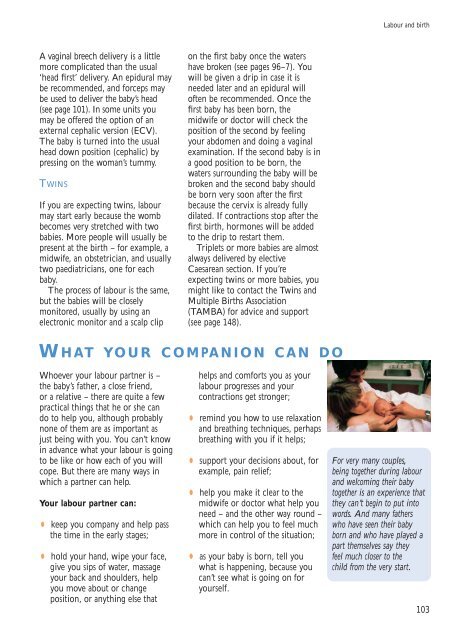here - Health Promotion Agency
here - Health Promotion Agency
here - Health Promotion Agency
Create successful ePaper yourself
Turn your PDF publications into a flip-book with our unique Google optimized e-Paper software.
Labour and birth<br />
A vaginal breech delivery is a little<br />
more complicated than the usual<br />
‘head first’ delivery. An epidural may<br />
be recommended, and forceps may<br />
be used to deliver the baby’s head<br />
(see page 101). In some units you<br />
may be offered the option of an<br />
external cephalic version (ECV).<br />
The baby is turned into the usual<br />
head down position (cephalic) by<br />
pressing on the woman’s tummy.<br />
TWINS<br />
If you are expecting twins, labour<br />
may start early because the womb<br />
becomes very stretched with two<br />
babies. More people will usually be<br />
present at the birth – for example, a<br />
midwife, an obstetrician, and usually<br />
two paediatricians, one for each<br />
baby.<br />
The process of labour is the same,<br />
but the babies will be closely<br />
monitored, usually by using an<br />
electronic monitor and a scalp clip<br />
on the first baby once the waters<br />
have broken (see pages 96–7). You<br />
will be given a drip in case it is<br />
needed later and an epidural will<br />
often be recommended. Once the<br />
first baby has been born, the<br />
midwife or doctor will check the<br />
position of the second by feeling<br />
your abdomen and doing a vaginal<br />
examination. If the second baby is in<br />
a good position to be born, the<br />
waters surrounding the baby will be<br />
broken and the second baby should<br />
be born very soon after the first<br />
because the cervix is already fully<br />
dilated. If contractions stop after the<br />
first birth, hormones will be added<br />
to the drip to restart them.<br />
Triplets or more babies are almost<br />
always delivered by elective<br />
Caesarean section. If you’re<br />
expecting twins or more babies, you<br />
might like to contact the Twins and<br />
Multiple Births Association<br />
(TAMBA) for advice and support<br />
(see page 148).<br />
W HAT YOUR COMPANION CAN DO<br />
Whoever your labour partner is –<br />
the baby’s father, a close friend,<br />
or a relative – t<strong>here</strong> are quite a few<br />
practical things that he or she can<br />
do to help you, although probably<br />
none of them are as important as<br />
just being with you. You can’t know<br />
in advance what your labour is going<br />
to be like or how each of you will<br />
cope. But t<strong>here</strong> are many ways in<br />
which a partner can help.<br />
Your labour partner can:<br />
•<br />
keep you company and help pass<br />
the time in the early stages;<br />
• hold your hand, wipe your face,<br />
give you sips of water, massage<br />
your back and shoulders, help<br />
you move about or change<br />
position, or anything else that<br />
helps and comforts you as your<br />
labour progresses and your<br />
contractions get stronger;<br />
• remind you how to use relaxation<br />
and breathing techniques, perhaps<br />
breathing with you if it helps;<br />
•<br />
support your decisions about, for<br />
example, pain relief;<br />
• help you make it clear to the<br />
midwife or doctor what help you<br />
need – and the other way round –<br />
which can help you to feel much<br />
more in control of the situation;<br />
•<br />
as your baby is born, tell you<br />
what is happening, because you<br />
can’t see what is going on for<br />
yourself.<br />
For very many couples,<br />
being together during labour<br />
and welcoming their baby<br />
together is an experience that<br />
they can’t begin to put into<br />
words. And many fathers<br />
who have seen their baby<br />
born and who have played a<br />
part themselves say they<br />
feel much closer to the<br />
child from the very start.<br />
103

















